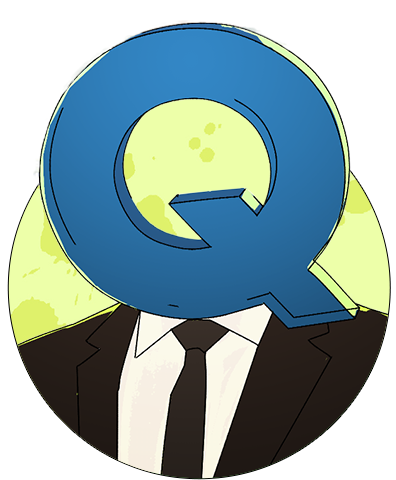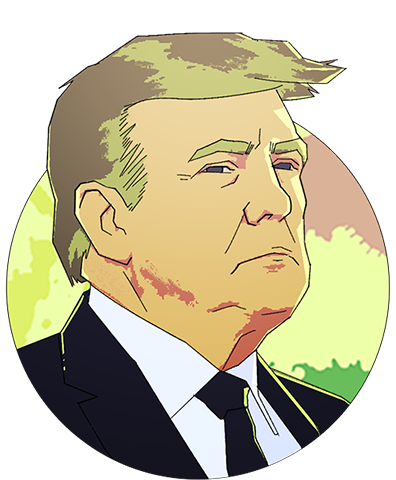Take a trip down another rabbit hole — Click a face for more stories
It’s tempting to think that before the COVID-19 pandemic, the QAnon conspiracy theory spent two years quietly worming its way into America’s darkest internet swamps while nobody else paid attention. And it’s just as easy to think that even without serious examination from journalists, tech companies, or law enforcement, the Q movement still needed a once-in-a-century viral outbreak to jump from the conspiracy pits into the mainstream.
But the truth is that QAnon received mainstream attention almost immediately. And the person who gave it that attention, albeit indirectly, was the most prolific giver-and-taker of attention of the last five years: President Donald Trump.
It wasn’t much, at first. And it was possibly incidental. But Q hadn’t even existed for a month before Trump retweeted a prolific QAnon-promoting Twitter account. While the tweet Trump shared had nothing to do with Q, it was a harbinger of what was to come—dozens of retweets by Trump of Q personalities, Q memes, and Q slogans, a deluge of misinformation and conspiracy. Even before the vast majority of people had even an inkling of what Q was, the president was giving one of its earliest promoters an audience of tens of millions of people. And we’ll never know how many people got a glimpse of that account and wanted in on what it was promoting.
In unearthing the story of Trump sharing that tweet, we can see the first glimmers of how QAnon would eventually become so mainstream that its wild ideas became principal drivers of conservative thought. QAnon is the discredited theory that a member of Trump’s inner circle is posting secret information (drops) on a right-wing messageboard about how the Democratic party and entrenched government employees are actually satanic pedophiles.
But the first time Trump shared QAnon content, Q was so new that it’s likely that nobody on his staff had any idea what it was.
On Nov. 25, 2017, just weeks after the first Q drops on 4chan, Trump retweeted an account called @MAGAPILL, sharing a link to a site they’d created called “THE President Donald Trump Accomplishment List Website.” Trump’s caption on the tweet perfectly sums up the high regard he held himself and his administration in, declaring, “Wow, even I didn’t realize we did so much. Wish the Fake News would report! Thank you.”
It’s not clear how Trump saw the “accomplishment list,” as it was a reply to a previous Trump tweet. Did Trump see it himself? Did someone on his staff bring it to him? Trump seems to retweet people almost at random, often spotlighting extremely small accounts and sharing both praise and things that make him angry. Trump routinely used Twitter to praise himself and to share praise from others—thousands of times over the course of his administration. The process by how he skims his Twitter feed, and whether he’s the one who actually does it, has never been clear, but if Trump saw a list of all the things he’d accomplished, it’s not a surprise that he’d share it.
But @MAGAPILL was no ordinary red hat-wearing Trump disciple. They were also a supporter of the nascent conspiracy theory going by the names “The Storm” and “QAnon.” In fact, @MAGAPILL was an early devotee of the “inside information” being dished by the “Q Clearance Patriot.”
They were so enthralled by Q that they published an entire blog post on Nov. 19 claiming “Q appears to have connections at the highest levels and has posted many things that seem to verify that he/she is the real deal,” and announcing that Q’s drops were “a once in a lifetime opportunity take out this Global Cabal of Satan worshiping pedophiles.”
Just hours before Trump retweeted their “Accomplishment List,” @MAGAPILL used #QAnon in a (now-deleted) tweet making a big deal out of Trump’s claim that he’d “only stayed in Washington 17 times” before being elected president. Since Q is the 17th letter of the alphabet, Q believers thought Trump was shouting them out.
This delighted the small but rapidly growing community of Q fans on the chan boards and Reddit. They were thrilled that Trump had shared a tweet from someone who believed the same conspiracy theory they were falling for. And @MAGAPILL was already a popular Trump news aggregator by then.
“Trump retweeted @magapill Trump Accomplishment List. magapill is discussing Q heavily. This is Winning Bigly,” wrote one Q fan on 8chan; with another boldly declaring “Trump’s retweet of the magapill article appears to be an endorsement of the view that secret indictments established by Meuller [sic] are on the verge of being disclosed, thereby triggering many further revelations that will awaken the general public.” (Like many 8chan posts from this time, these no longer exist anywhere but in the archive on Q drop aggregator site qrearch.ch.)
Looking back, it’s clear how important it was to Q believers that Trump shared content from one of their own. It sowed the seeds for the problems we have today.
Q has created a false reality where the deep state conspired to rig the 2020 election in favor of Joe Biden—and it’s a reality that the president himself has embraced and reflected back to his most fervent followers, who are eager to embrace it. And it led them to storm the Capitol in defense of Trump, an insurrectionist culmination for the conspiracy. If a cultish conspiracy theory that high-ranking Democrats were actually a cabal of pedophiles could be promoted by someone who, in turn, was promoted by the president of the United States, why would you think you were being being duped? Rather, you’d believe it more fervently.
Now, it’s the only thing a number of people take seriously.
The violent seeds of Q’s alternate reality were already being planted in the first drops. And the vast majority of media outlets completely missed it in the rush to write off the conspiracy theories of @MAGAPILL and the like as crazy. Years later, they are still playing catch up.
But they shouldn’t have been. Because Trump was right there, sowing the seeds from day one.











